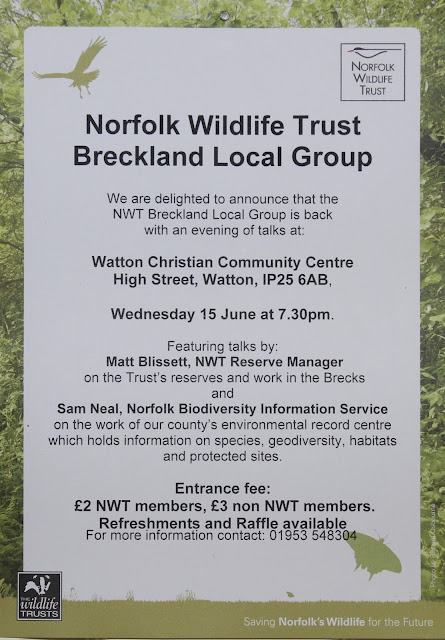I was first to arrive at the NWT car park at Cley. What a lovely sound it was to hear cattle lowing on the marsh, in a couple of hours this would be drowned out by the sound of passing traffic. Whilst waiting for Richard I did a little exploring of the immediate area and was entertained by a lovely male Whitethroat, he had chosen the topmost part of a Hawthorn to sing from. Also noted was both Reed and Sedge Warblers singing from the nearby marsh.
 |
| Whitethroat (male) at Cley 27/05/16 |
Richard arrived at about 0530, and after a nice chat we opted to do an anti-clockwise walk around the marshes. Setting off along the path adjacent to the road we encountered typical species including Sedge Warblers and a single calling Cetti's Warbler. A pair of Marsh Harriers were seen to perform a food pass, a sure sign of successful breeding. We decided to visit a hide where we had close views of Avocet, few other waders were seen. A pair of Shelduck were accompanied by 5 small fluffy young ducklings. It was whilst in the hide that we were joined by Mick Colman, a friend of Richards. Mick remained with us for the day, what a lovely man he is.
Walking along East Bank we encountered Reed Warblers which often showed well clinging onto reeds. Probably the greatest numbers of Sedge Warblers were seen from East Bank with males often performing their conspicuous song-flight. On the east side of East Bank, a Redshank was accompanied by 3 chicks, the parent bird often calling the young to join her. She was also seen to brood her young on one occasion. Lapwing also seen here. As we continued n north along East Bank a number of Meadow Pipits collected food from the path and nearby grasses and weeds and eventually flew off to feed young birds. At the north end of East Bank, an interesting observation of a single female Whitethroat in an out-of-breeding habitat, given the distance from breeding habitat, was this lovely Whitethroat a very late migrant brought here by the moderate north-easterly wind?
A check of the dykes and pools alongside East bank produced 2 Pochard (pair), 4 Tufted Duck, Gadwall, and Mallard.
 |
| Sedge Warbler at Cley - many singing and displaying birds seen |
Continuing along the boundary fence we reached the Eye field where 2 superb summer plumaged Golden Plovers dropped in. Skylarks and Meadow Pipits continued to be seen.
A short break for a bite to eat then we continued south along the West bank. Once again, Meadow Pipits dominated with birds carrying food for young. Reed Buntings were seen. At the southern end of West bank Reed Warblers were seen in a traditional area of reeds near the turret.
The path adjacent to the coast road attracted many House Sparrows to the umbellifer species where I assumed they were collected food for young birds. Blue Tits and several House Martins were seen here.
 |
| Kestrel at Cley 27/05/16 |
Richard and Mick decided to visit the hides whilst I put my feet up for a while. They saw a Spoonbill and a couple of Ruff from the hide. The reeds in this area held a fine, and close singing Reed Bunting, also Reed Warblers sang in tall reeds out of view. A single Wren entertained by singing for some while on a post by the hide. Overhead, a gathering of 30+ Swifts were probably attracted to a food source.
We finally arrived back at the NWT car park some 7 hours after setting off and to greet our return was the beautiful male Whitethroat singing from various bushes around his territory where we had left him on the start of our walk at 0530.
Also seen/heard around the car park was Blackbirds, Blackcap, and a fine looking Kestrel hovering overhead.
I will finish this account by thanking my good friend Richard Farrow and Mick Colman for joining me on this fantastic days birding.







